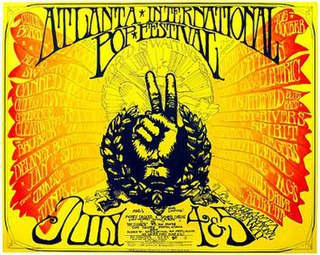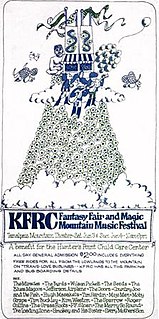
William Smith Monroe was an American mandolinist, singer, and songwriter, who created the bluegrass music genre. Because of this, he is often called the "Father of Bluegrass".

Earl Eugene Scruggs was an American musician noted for popularizing a three-finger banjo picking style, now called "Scruggs style", which is a defining characteristic of bluegrass music. His three-finger style of playing was radically different from the traditional way the five-string banjo had previously been played. This new style of playing became popular and elevated the banjo from its previous role as a background rhythm instrument to featured solo status. He popularized the instrument across several genres of music.

Country Joe and the Fish was an American psychedelic rock band formed in Berkeley, California, in 1965. The band was among the influential groups in the San Francisco music scene during the mid- to late 1960s. Much of the band's music was written by founding members Country Joe McDonald and Barry "The Fish" Melton, with lyrics pointedly addressing issues of importance to the counterculture, such as anti-war protests, free love, and recreational drug use. Through a combination of psychedelia and electronic music, the band's sound was marked by innovative guitar melodies and distorted organ-driven instrumentals which were significant to the development of acid rock.

A rock festival is a series of musical performances by a variety of artists, which generally take place over a number of days. Some festivals are singular events, while others recur annually in the same location. Occasionally, a festival will focus on a particular genre, but many attempt to bring together a diverse lineup to showcase a broad array of popular music trends.

The Monterey International Pop Music Festival was a three-day concert event held June 16 to 18, 1967, at the Monterey County Fairgrounds in Monterey, California. The festival is remembered for the first major American appearances by the Jimi Hendrix Experience, the Who and Ravi Shankar, the first large-scale public performance of Janis Joplin and the introduction of Otis Redding to a mass American audience.

The Isle of Wight Festival 1970 was held between 26 and 31 August 1970 at Afton Down, an area on the western side of the Isle of Wight in England. It was the last of three consecutive music festivals to take place on the island between 1968 and 1970 and often acknowledged as the largest musical event of its time, with a larger attendance than Woodstock. Although estimates vary, Guinness World Records estimated 600,000 to 700,000 people attended. It was organised and promoted by local brothers, Ron and Ray Foulk through their company Fiery Creations Ltd and their brother Bill Foulk. Ron Smith was site manager and Rikki Farr acted as compere.

Chester William Powers, Jr. was an American singer-songwriter, and under the stage names Dino Valenti or Dino Valente, one of the lead singers of the rock group Quicksilver Messenger Service. As a songwriter, he was known as Jesse Oris Farrow. He is best known for writing the quintessential 1960s love-and-peace anthem "Get Together", and for writing and singing on Quicksilver Messenger Service's two best-known songs, "Fresh Air" and "What About Me?"

Fred Neil was an American folk singer-songwriter active in the 1960s and early 1970s. He did not achieve commercial success as a performer and is mainly known through other people's recordings of his material – particularly "Everybody's Talkin'", which became a hit for Harry Nilsson after it was used in the film Midnight Cowboy in 1969. Though highly regarded by contemporary folk singers, he was reluctant to tour and spent much of the last 30 years of his life assisting with the preservation of dolphins.

"Hey Joe" is an American song from the 1960s that has become a rock standard and has been performed in many musical styles by hundreds of different artists. The lyrics tell of a man who is on the run and planning to head to Mexico after shooting his unfaithful wife. In 1962, Billy Roberts registered "Hey Joe" for copyright in the United States.
Jim Murray was a guitarist and harmonica player for the psychedelic blues rock band Quicksilver Messenger Service. He also handled lead and background vocals on some songs. He left the band in late 1967 shortly before they recorded their first album.

The first Atlanta International Pop Festival was a rock festival held at the Atlanta International Raceway in Hampton, Georgia, twenty miles south of Atlanta, on the July Fourth (Friday) weekend, 1969, more than a month before Woodstock. Crowd estimates ranged from the high tens of thousands to as high as 150,000. With temperatures nearing a hundred degrees, local fire departments used fire hoses to create "sprinklers" for the crowd to play in and cool off. It was a peaceful, energetic, hot and loud festival with few problems other than heat related. Concession stands were woefully inadequate. Attendees frequently stood in line for an hour to get a soft drink.

The second Atlanta International Pop Festival was a rock festival held in a soybean field adjacent to the Middle Georgia Raceway in Byron, Georgia, from July 3–5, 1970, although it did not finish until after dawn on the 6th. It was the only successor to the first Atlanta Pop Festival, which had been held the previous summer near Hampton, Georgia. The event was promoted by Alex Cooley, who had helped organize the '69 Atlanta festival as well as the '69 Texas International Pop Festival, and two years later would promote the Mar Y Sol Pop Festival in Puerto Rico from April 1–3, 1972.
William Moses Roberts Jr. was an American songwriter and musician credited with composing the 1960s rock music standard "Hey Joe".
"I Shall Be Released" is a 1967 song written by Bob Dylan.

The Miami Pop Festival is the name by which a music festival that took place on May 18-19, 1968, in Hallandale, Florida, is sometimes known. The venue was Gulfstream Park, a horse racing track just north of Miami. The event, which was officially publicized on promotional materials and in radio ads as the "1968 Pop and Underground Festival," and "The 1968 Pop Festival," was promoted by Richard O'Barry and Michael Lang, the latter of whom became famous as one of the four promoters of Woodstock in 1969. Decades later, the May 1968 festival began to be referred to colloquially as the "Miami Pop Festival", leading to confusion with the actual Miami Pop Festival, which took place in December 1968.

The KFRC Fantasy Fair and Magic Mountain Music Festival was an event held June 10 and 11, 1967 at the 4,000-seat Sidney B. Cushing Memorial Amphitheatre high on the south face of Mount Tamalpais in Marin County, California. Although 20,000 tickets were reported to have been sold for the event, as many as 40,000 people may have actually attended the two-day concert, which was the first of a series of San Francisco–area cultural events known as the Summer of Love. The Fantasy Fair was influenced by the popular Renaissance Pleasure Faire and became a prototype for large scale multi-act outdoor rock music events now known as rock festivals.

The Atlantic City Pop Festival took place in 1969 on August 1, 2 and 3rd at the Atlantic City race track, two weeks before Woodstock Festival. It actually took place in Hamilton Township at the Atlantic City Race Course. There was heavy security at the festival, and the stage the acts performed on was created by Buckminster Fuller. A ticket for the entire 3-day weekend was $15.00 to see all of the performers listed. Attended by some 100,000+ people.

The Schaefer Music Festival in Central Park was a recurring music festival held in the summer between 1967 and 1976 at Wollman Rink in New York City's Central Park. It featured a number of notable performances. The sponsorship was taken over by Dr. Pepper in 1977 and the name changed to the Dr. Pepper Central Park Music Festival until the location of the festival was moved to Pier 84 in 1981 and the Wollman Skating Rink ceased being used as a concert venue.

The Newport Pop Festival, held in Costa Mesa, California, on August 3–4, 1968, was the first music concert ever to have more than 100,000 paid attendees. Its sequel, billed as Newport 69, was held in Northridge, California, on June 20–22, 1969, and had a total attendance estimated at 200,000.
Tom Rounds was an American radio broadcasting executive, founder and chief executive officer of Radio Express in Burbank, California.
















